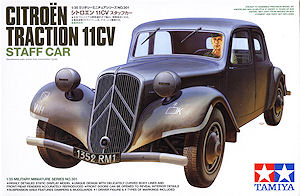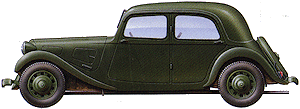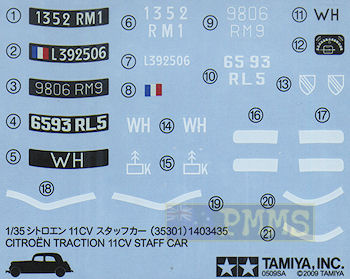The Citroën 11CV began production in 1934 and featured a front mounted inline four-cylinder 1900cc engine installed longitudinally with front wheel drive and front/rear torsion bar suspension.
The name should actually be Traction Avant which is French for "front wheel drive" with the French Army employing many of the vehicles. The German Army commandeered large numbers of them after 1940 and put them to use from North Africa to Russia, while many Luftwaffe pilots preferred to use the Traction Avant as a staff car.
The French Resistance also used the Traction Avant, while the Free French army recaptured and deployed them after the Normandy invasion.
In the post-war years, the Traction Avant stayed in production until 1957, with a total of 760,000 built
Tamiya have followed their 1:48 kit of the Citroën Traction 11CV (kit #32517) with this rendition in 1:35 scale and as you might expect the parts break down is basically the same as the 1:48 with some additional parts and detail due to the larger scale, but overall this is still a fairly simply kit.
The kit has just 54 parts in the usual Tamiya dark grey plastic with a further 8 in clear plastic as well as 4 poly caps for the wheels plus the decal and instruction sheets.
The standard of moulding is the usual Tamiya with crisp clean parts and virtually no pin marks to be seen with just the normal minor moulding seams to be removed from the parts.
The wheels are moulded in three parts, the outer wheel rim and tyre, separate rear rim insert and an inner disc that traps the poly cap in place which allows the wheels to easily be fitted to the axles. The tread pattern is nicely done with the distinctive central wavy tread pattern as depicted on the box top and images of wartime civilian Tractions.
There is a separate front and rear axle added to the chassis but the front wheels are fixed in the neutral position and it would take a bit of work to change the angle if you wanted to show the wheels turned for a bit of animation.
The lower chassis is a single moulding with the front and rear bumper mountings included with separate lower suspension arms that trap the axle in place as well as a separate full length exhaust pipe and muffler with the pipe slightly opened out at the rear outlet.
On the inside are the two front seats and single rear bench seat but there are no driver's foot pedals included, being a typical Tamiya trait with softskin kits.
The front fenders are moulded as one piece to which is added the engine firewall and dashboard along with a small decal for the instrument panel details, the steering wheel/column is added to the firewall but the gear shift and indicator levers are not included. The instructions show to fit the fenders to the lower chassis with the body added later but I found it easier to attach the fenders to the body shell before adding this to the chassis.
There are separate front and rear bumper bars which are moulded nice and thin as well as head lights with a choice of separate black out covers or clear plastic lenses depending on the finish. The bumper mounting brackets included with the chassis have substantial moulding seams that will need to be removed before adding the bumper bars.
The main body is a single moulding with very good external details of engraved door lines and other panel details as well as fine raised details such as the door hinges with the two front doors being separate parts allowing these to be shown open if you wish. There are some fine moulding lines to be removed from the rear corner and fender and along the hood sides but these are extremely fine and won’t take much to remove.
All the door handles are small separate parts and you need to take care to position the door handles correctly as they are different front and rear due to the doors opening in opposite directions, these are also very small and need careful handling.
The windows are included as separate clear parts that fit from the outside of the body but some minor trimming of the edges may be needed for a more precise fit, mostly on the front windscreen and rear window on my kit. There are separate wiper blades for the windscreen but these are a little on the thick side and could do with being thinned down somewhat. Included with the kit are mask stencils that you can use to cut masks from tape for the windows to aid painting as the clear window parts also include the frames.
Added to the front is the separate radiator grill with engraved grill bars and the raised inverted V and this fits neatly to the front of the engine bay by way of a large internal locating lug. The only issue with the radiator is the vertical bars are solid and not open (common issue with radiator grills on kits) and the appearance would be improved with open bars although there is nothing inside if they were?
At the back is the separate number plate, fuel filler cap, separate small boot handles and spare wheel cover with all these fitting without any problems.
The fit of the body shell to the chassis is perfect without the need for any trimming due to three large locating pins/lugs on the chassis that ensure perfect alignment; this makes it easy to paint the interior before final assembly.ssembly.
Included with the kit is a German driver wearing standard tunic, trousers and leather boots and field cap. This is in 5 parts with the left arm posed to rest on the steering wheel.
Detail on the figure is adequate as far as kit driver figures go and fits neatly onto the seat with the hand mating perfectly to the steering wheel. It would have been nice to have a civilian or French Army driver but there should be resin alternatives available.
About the only thing missing for the Wehrmacht version is the Notek light mounted on the left fender but this is easy enough to find elsewhere if required.
These are the usual Tamiya exploded view drawings that are very clear and easy to follow but as with any instructions you should study these before any assembly to avoid any mistakes or misinterpretation.
|
1:35 modellers have been salivating for this kit ever since the 1:48 kit was released in 2005 and now here it is.
It’s basically an up-scaled version of the 1:48 kit as you would expect with additional details added such as the open front doors, separate windscreen wipers, door handles and finer detail due to the larger size.
Typical Tamiya fit and the small number of parts makes it a quick and easy assembly for a rainy Sunday arvo and will be very welcomed by all vehicle modellers.
Highly recommended
Click on thumbnails for larger view



Detail images


Close new window to return to review
 for
the review kit.
for
the review kit. 



